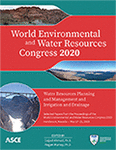World Environmental and Water Resources Congress 2020
Effect of Alternate Irrigation with Fresh and Saline Waters on Soil Profile Salinity and Chemical Properties
Publication: World Environmental and Water Resources Congress 2020: Water Resources Planning and Management and Irrigation and Drainage
ABSTRACT
A greenhouse study was conducted to investigate the effects of irrigating with different levels of water salinities followed by freshwater application on soil profile salinity and chemical properties under Bermudagrass. Irrigating with saline water increased soil extract electrical conductivity (ECe) at all layers, but the impact was significantly larger for the top 5 cm of the soil. The application of freshwater at the end of the experiment significantly reduced ECe, especially for topsoil. Soil sodicity was not impacted, mainly due to the combination of salts selected for reaching the target salinity levels of irrigation water. Soil acidity increased with irrigation water salinity, but the application of freshwater did not have any impact on changing pH levels. The changes in concentrations of four major cations (sodium, calcium, potassium, and magnesium) were similar to those observed for ECe.
Get full access to this article
View all available purchase options and get full access to this chapter.
REFERENCES
Abrol, I. P., Yadav, J. S. P., & Massoud, F. I. (1988). Salt-affected soils and their management(No. 39). Rome: Food and Agriculture Organization of the United Nations.
Ayers, R. S., & Westcot, D. W. (1985). Water quality for agriculture(No. 29). Rome: Food and Agriculture Organization of the United Nations.
Blanco, F. F., & Folegatti, M. V. (2002). Salt accumulation and distribution in a greenhouse soil as affected by salinity of irrigation water and leaching management. Revista brasileira de engenharia agricola e ambiental, 6(3), 414-419.
Chang, A. C., & Brawer Silva, D. (2016). Salinity and drainage in San Joaquin Valley, California. Springer.
Chauhan, S. K., Chauhan, C. P. S., & Minhas, P. S. (2007). Effect of cyclic use and blending of alkali and good quality waters on soil properties, yield and quality of potato, sunflower and Sesbania. Irrigation Science, 26(1), 81-89.
Choudhary, O. P. (2017). Long-Term Impact of Cyclic Use of Sodic and Canal Waters for Irrigation on Soil Properties and Crop Yields in Cotton–Wheat Rotation in a Semiarid Climate. Agricultural Research, 6(3), 267-272.
Corwin, D. L., Rhoades, J. D., & Šimůnek, J. (2007). Leaching requirement for soil salinity control: Steady-state versus transient models. Agricultural Water Management, 90(3), 165-180.
Crescimanno, G., & Garofalo, P. (2006). Management of irrigation with saline water in cracking clay soils. Soil Science Society of America Journal, 70(5), 1774-1787.
Fujimaki, H., Ando, Y., Cui, Y., & Inoue, M. (2008). Parameter estimation of a root water uptake model under salinity stress. Vadose Zone Journal, 7(1), 31-38.
Ghassemi, F., Jakeman, A. J., & Nix, H. A. (1995). Salinisation of land and water resources: human causes, extent, management and case studies. CAB international.
Haj-Amor, Z., Ibrahimi, M. K., Feki, N., Lhomme, J. P., & Bouri, S. (2016). Soil salinisation and irrigation management of date palms in a Saharan environment. Environmental monitoring and assessment, 188(8), 497.
He, K., Yang, Y., Yang, Y., Chen, S., Hu, Q., Liu, X., & Gao, F. (2017). HYDRUS simulation of sustainable brackish water irrigation in a winter wheat-summer maize rotation system in the North China Plain. Water, 9(7), 536.
Qadir, M., Wichelns, D., Oster, J., Jacobsen, S. E., Basra, S. M. A., & Choukr-Allah, R. (Eds.). (2010). Sustainable Management of Saline Waters and Salt-Affected Soils for Agriculture: Proceedings of the Second Bridging Workshop, 15-18 Nov 2009, Aleppo, Syria. International Center for Agricultural Research in the Dry Areas, (ICARDA), PO Box, 5466.
Minhas, P. S., Dubey, S. K., & Sharma, D. R. (2007). Comparative affects of blending, intera/inter-seasonal cyclic uses of alkali and good quality waters on soil properties and yields of paddy and wheat. Agricultural Water Management, 87(1), 83-90.
Rhoades, J. D., Kandiah, A., & Mashali, A. M. (1992). The use of saline waters for crop production(No. 48). Rome: Food and Agriculture Organization of the United Nations.
Richards, L. A. (1954). Diagnosis and improvement of saline and alkali soils (Vol. 78, No. 2, p. 154). LWW.
Sikora, F. J. (2006). A buffer that mimics the SMP buffer for determining lime requirement of soil. Soil Science Society of America Journal, 70(2), 474-486.
Sims, J. T. (1996). Lime requirement. Methods of Soil Analysis Part 3—Chemical Methods, 491-515.
Soltanpour, P. N., Johnson, G. W., Workman, S. M., Jones Jr, J. B., & Miller, R. O. (1996). Inductively coupled plasma emission spectrometry and inductively coupled plasma-mass spectrometry. Methods of Soil Analysis Part 3—Chemical Methods, 91-139.
Sou, M. Y., Mermoud, A., Yacouba, H., & Boivin, P. (2013). Impacts of irrigation with industrial treated wastewater on soil properties. Geoderma, 200, 31-39.
Wang, X., Liu, G., Yang, J., Huang, G., & Yao, R. (2017). Evaluating the effects of irrigation water salinity on water movement, crop yield and water use efficiency by means of a coupled hydrologic/crop growth model. Agricultural water management, 185, 13-26.
Yurtseven, E., Šimůnek, J., Avcı, S., & Öztürk, H. S. (2013). Comparison of HYDRUS-1D simulations and ion (salt) movement in the soil profile subject to leaching. In The 4th international conference “HYDRUS software applications to subsurface flow and contaminant transport problems”. (Eds J Šimůnek, R Kodesova) pp (pp. 395-404).
Zeng, W., Xu, C., Wu, J., & Huang, J. (2014). Soil salt leaching under different irrigation regimes: HYDRUS-1D modelling and analysis. Journal of Arid Land, 6(1), 44-58.
Information & Authors
Information
Published In
World Environmental and Water Resources Congress 2020: Water Resources Planning and Management and Irrigation and Drainage
Pages: 47 - 56
Editors: Sajjad Ahmad, Ph.D., and Regan Murray, Ph.D.
ISBN (Online): 978-0-7844-8295-7
Copyright
© 2020 American Society of Civil Engineers.
History
Published online: May 14, 2020
Published in print: May 14, 2020
Authors
Metrics & Citations
Metrics
Citations
Download citation
If you have the appropriate software installed, you can download article citation data to the citation manager of your choice. Simply select your manager software from the list below and click Download.
